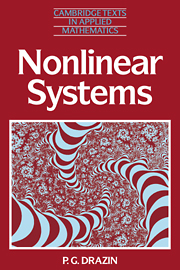Book contents
- Frontmatter
- Contents
- Preface
- 1 Introduction
- 2 Classification of bifurcations of equilibrium points
- 3 Difference equations
- 4 Some special topics
- 5 Ordinary differential equations
- 6 Second-order autonomous differential systems
- 7 Forced oscillations
- 8 Chaos
- Appendix A Some partial-differential problems
- Appendix B Additional problems
- Answers and hints to selected problems
- Bibliography and author index
- Motion picture and video index
- Subject index
- Plate section
Appendix A - Some partial-differential problems
Published online by Cambridge University Press: 05 June 2012
- Frontmatter
- Contents
- Preface
- 1 Introduction
- 2 Classification of bifurcations of equilibrium points
- 3 Difference equations
- 4 Some special topics
- 5 Ordinary differential equations
- 6 Second-order autonomous differential systems
- 7 Forced oscillations
- 8 Chaos
- Appendix A Some partial-differential problems
- Appendix B Additional problems
- Answers and hints to selected problems
- Bibliography and author index
- Motion picture and video index
- Subject index
- Plate section
Summary
We have seen that bifurcations and chaos for a system of difference or ordinary differential equations often occur in lower dimensions than the dimension of the system. Similarly, although a partial differential system has an infinite dimension, its bifurcations and chaos often occur in a manifold of low finite dimension. Indeed, turning points, transcritical bifurcations, pitchfork bifurcations, Hopf bifurcations, limit cycles etc. arise for partial differential systems. This can be demonstrated in many cases by use of one of a few perturbation techniques, for example the Liapounov- Schmidt reduction or centre manifold theory. The essence of these techniques is to consider perturbations of marginal stability in which the values of both the parameters and the state variables are close to those corresponding to marginal stability, and in which the effects of these two kinds of perturbations are balanced asymptotically. At the margin of stability, the number of eigenvalues whose real parts are zero is usually small, so that their eigenfunctions span a low-dimensional space; all components of an initial disturbance not in this space being strongly damped. The centre manifold of a weakly nonlinear system is tangential to this space as the margin of stability is approached.
The fact that phenomena of interest occur in a low-dimensional manifold makes the dynamics much easier to understand, but it seems that some phenomena, for example turbulent motion of a fluid, cannot be represented in a low-dimensional manifold.
- Type
- Chapter
- Information
- Nonlinear Systems , pp. 283 - 289Publisher: Cambridge University PressPrint publication year: 1992



